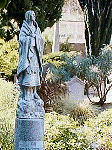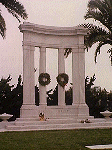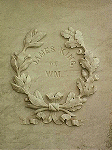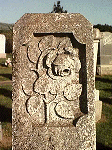| Anchor
Early Christians devised clever signs so that they could guide one another to the secret places where they worshipped. The anchor is a disguised cross when you see it in a Christian setting. From its utility, the further meaning of Christ as that which prevents us from drifting off and becoming lost comes. One rarely sees anchors on inland gravestones, so the presence of the symbol on a tomb may carry all the above religious overtones or it may just mean that the deceased was a sailor. An anchor with a broken chain stands for the cessation of life.
|
| Angels
Creatures made of air or fire according to early Christian pseudepigraphica, or of granite or marble, if a stonecutter makes them. Angels mean spirituality. They guard the tomb, guide the soul, pray for the soul in purgatory, and direct the living visitor to think heavenwards. Two angels, saints of the Catholic Church, can be named as we find them: Michael, who bears a sword, and Gabriel, who toots a horn. Angels shown without one or the other of these artifacts belong to the nameless legions of personal guardian angels and other decorations.
|
Colors
If asked to name the color of death and mourning, Europeans will choose black. Chinese, other Asians, and many other groups will pick white. Black signifies darkness and the absence of light. It also recalls the silence in the middle of the night. White recalls the color of the bones and the paleness of the corpse. The difference is not perfect because Europeans fill their graveyards with white tombstones. White doves also appear as motifs in the European sepulchral arts.
Catholics and High-Church Anglicans recognize purple as the color of mourning. Priests wear purple or violet robes at funeral masses for the dead, recalling Christ's passion, crucifixion, and resurrection.
See also red lettering. |
| Broken Column
What we see today of ancient Greek and Roman civilization. Because the men and women who built monuments such as the Parthenon are dead, this image represents the eventual ruin or decomposition of us all.
|
| Crescent
Denotes that the deceased was a Muslim in life.
|
Cross
Christians behold the hope of resurrection in the cross. The cross can also stand for nationalist divisions, especially between the Western Church and the Eastern. Orders of crusading knights often devised their own crosses as they set forth to pillage infidels and fellow Christians. The cross also appears in Japanese heraldry where it stands for the four quarters of the earth or the four cardinal directions. Or it merely pleases the eye.
See anchor, SIGNS OF THE CROSS. |
| Crown
The crown atop the head of many saints and a few worldly devils attests to the soul's achievement. Early crowns were made out of plants and derived their meaning from those herbs. As men fashioned crowns out of more enduring substances like gold, they added little spikes to call to mind the power and authority of the sun. |
| DogDogs often appear at the feet of medieval women, signifying the loyalty and inferior place of each in the chivalric order. Modern dogs only imply that the master was worth loving. |
Dove
The little bird appears in both Christian (usually Catholic) and Jewish cemeteries, representing some of the same things and some different things in each. Catholics usually see the dove (which makes its first Biblical appearance in Genesis carrying an olive branch for Noah) as the Holy Spirit. Jews interpret the dove as a peace symbol. The biblical allusion to the dove also suggests a connectedness with the earth and its color, white, represents for Europeans, purity and spirituality.
See also colors. |
Dragon
For the Chinese, the dragon is an emblem of Imperial Power, which has brought the universe into its thrall. It also stands for the Universe itself, a chaotic force which none of us can truly master.
Europeans rarely depict dragons on their gravestones. When they appear, Saint George rides out to kill them. This symbolizes triumph over sin. And when one triumphs over Sin, one has also won relief from the most stinging qualities of Death: the punishments for our sins.
|
Foo Dog
Guardian beings found at the gates of many Chinese cemeteries. Foo dogs are what resulted when Indian Buddhist missionaries described lions to Chinese artists (who had no such creature lurking in their woods.) One male and one female foo dog guard each assigned entryway. The male, sitting on the right as you enter the gate, holds down a ball, sometimes painted gold. This signifies the authority of the man over the family's worldly affairs. The female, sitting on the left, holds down a kitten. She rules the domestic life, including the raising of the children and the management of the household. These relationships, like all familial ties, persist into death.
See also sphinx.
|
Hands
The hand may be the most distinctly human appendage. We spend our lives with our hands right in front of us, reaching, touching, fingering, scratching, and doing much of the work our lives require. Early man blew paint around his hand, leaving a clear mark that he'd visited certain of the caves of Southern France.
Cemetery hands tend to be shown doing one of four things: clasping, praying, pointing, and blessing. All these signs show that the deceased's relationships involve human beings. The hand says "Here I lived". From the fact of this life, the hand directs us to spiritual matters (e.g. the presence of God) or to the endurance of human feelings (clasping hands often symbolize a marriage or other close bond).
|
| Heart
Stylized hearts stand for the affection of the living for the dead. Two joined hearts on a stone mark a marriage.
|
| Heart, Sacred
A grisly image unique to Catholic memorial parks. The Sacred Heart depicts the torn and dripping cardiac muscle of Jesus, surrounded, for good measure, with the crown of thorns. The heart represents the suffering of Jesus for our sins. Prayers to the Sacred Heart are said to be efficacious for the release of souls from Purgatory.
|
| Hour Glass
The classic symbol for Time. So far neither analog nor digital clocks have appeared on tombstones, perhaps because these represent time which is renewable while the sands of an hour glass run out. Hour glasses sometimes take flight. Some hold that this signifies the resurrection of the dead. Or it may be the realization of the adage "Time flies." |
| Keys
Newspapers sometimes write of the key to more knowledge that some scientist has discovered. This recalls modern science's ties to the medieval era, when alchemists held that there were three keys which, if discovered, would allow them to turn lead into gold. Cemetery keys stand for spiritual knowledge or, if held in the hands of an angel or saint (especially Peter), the means to enter heaven.
|
| Lamb
Usually marks the grave of a child, especially in a Catholic cemetery. The lamb always stands for innocence. Christians go a little further and associate it with the Lamb of God, meaning Jesus. Children have had little time to accumulate a roster of sins. For this reason, Catholics hold, once they have been baptized they possess the purest souls among us. (George Orwell once said: "One cannot really be a Catholic and grown up." The awe accorded the souls of children suggests that many Catholics feel that the only nearly perfect beings among us are our children.) Most lambs appear crouching. Some monuments show lambs with other symbols such as the cross, palm branches, crowns, chalices, etc. These lambs represent Jesus and those, such as bishops and other clergy, who serve Him.
|
LampLike other light sources, lamps stand for knowledge and the immortality of the Spirit.
See also sun, torch.
|
LionThe lion recalls the power of God and guards the tomb against impious visitors and evil spirits. Like other guardians, the lion's watch is as eternal as the stone or bronze in which it is depicted. These felines also recall the courage and determination of the souls which they guard: they can be said to manifest the spirit of the departed.
See also foo dog. |
| MenorahThe menorah far predates the mogen david as an emblem of Judaism. |
Pinwheels
This new phenomenon brings motion to otherwise still graveyards. First appearing on the graves of children, pinwheels now can be seen on the graves of adults. The continual movement suggests constancy, perhaps of affection. The wind which propels the tiny mills evokes the spirit. As with all the symbols mentioned in this glossary, people may choose to use them to express these meanings or just because they are pretty.
See also toys.
|
Plants
Experts cannot agree whether a tree growing in the grave of a husband and wife symbolizes their separation or unity. I tend towards the latter -- seeing marriage as a joining of two substances. This interpretation of plants as the embodiment of the deceased comes up often in literature and art. From our rotting remains, the grass, the trees, the flowers, and the shrubs draw up our essence. They can also have other meanings and uses.
See LIVING THINGS. |
Red Lettering
Chinese tombstones often appear before the decease of the commemorated. Red lettering shows that the person named is still alive. When that person dies, the stonecutter comes and repaints the letters in white.
See also colors. |
Saints
You can find just about any saint adorning a grave or cemetery plot. Saint Michael may be the most popular after the Virgin Mary. Saint Francis's deceased wards include both humans and animals. The choice of saint is up to the person who commissions the monument. If you want to get a good feel for who these people are, carry a good handbook of Saint biographies.
Consider as you explore why a particular saint appears where you find it. For example, a statue of Blessed Kateri Tekakwitha -- "the Lily of the Mohawks" -- stands in Mission Dolores Cemetery (see the picture at the top left). The inscription on her base dedicates her to "our faithful Indians". Those erecting the statue meant her as an inspiration: native Americans are expected to look to her as a model for religious behavior and the rest of us are to take pride in the universal appeal of the Catholic Christian tradition. Thinking beyond this, however, suggests an interesting purblindness: What is this Mohawk, who was to the Ohlone what the Spanish were to the Hungarians, doing here? One could write a long essay about how this monument betrays the way Euro-Americans intellectually homogenize native Americans (Mohawk=Ohlone) and turn them into possessions (think about "our Faithful Indians").
|
Scythe/Sickle
An instrument of the harvest, alluding to Christ's parable of the wheat field. Death cuts us down, after which the wheat is separated from the chaff. Medieval depictions of the Grim Reaper showed a rotting mass of walking putrescence: today, a kindly old man shoulders the blade. Artisans seldom depict him using it.
J.E. Cirlot claims that the scythe is a lunar symbol, which makes it both "feminine and passive". There are some problems with this interpretation. First, the scythe is always associated with a male figure -- Father Time, Death, or Saturn/Cronos (who aggressively sought to prevent his dethronement as King of the Universe by eating all his children!). Second, the carrier holds the scythe so that he can use it. Cirlot, like many Jungians eager to find repetition of certain cherished archetypes, overlooks these obvious points.
Why do we never see a scythe in use? Cemetery motifs sometimes function to communicate certain ideas. The scythe, on one hand, reminds us of the quickness of death -- that for all of us the harvest is coming. Cemetery owners and the clergy do not wish to frighten us, so for this reason modern figures of Time carry the scythe over their shoulders, making them as threatening as a band of colorful peasants on the way home from the fields.
|
Skull, Winged
A once common motif on New England tombstones. It represented death and the soul taking flight. Over a century, the skull grew skin and became a cherub.
See angel.
|
| Sphinx
One of many neo-Egyptian designs (along with obelisks and pyramids) which have crept into modern cemeteries. Two kinds of sphinxes appear: the male Egyptian sphinx modeled after the Great Sphinx at Giza and the female (and often barebreasted) Greek Sphinx. Both feature the head and torso of a human creature grafted to the body of a lion. Like foo dogs, sphinxes guard the tomb. |
Star
These pricks in night's veil suggest, to Christians, "the Light shining in the darkness, the Light that darkness could not overpower". Or as Mithras put it: "I am a star which goes with thee and shines out of the depths." Stars stand for the spirit, piercing the darkness as an expression of their triumph against the overwhelming odds of oblivion.
Five pointed stars have been used both to represent both the spirit rising to heaven and, when inverted, its treason as an instrument of Evil. The six-pointed star or mogen david, now recognized as the emblem of international Judaism, was but a minor motif until its adoption by the Zionist movement in the late 19th century.
See also sun, menorah.
|
Sun
A setting sun recalls to us that borderland between life and death where we are brought when we visit a cemetery. A symbol of light and warmth, it stands for life itself.
English Christians play on the word "sun" and connect it with the Son of God. The sun has also been called "God's Eye", looking down on all of us. This spirit by its brightness absorbs all others (e.g. the stars), illuminates the world for us, and brings us understanding.
|
| SundialA decoration intended to remind visitors of the nearness of the closing of the cemetery gate. |
| Tao Symbol
The Tao or the Way shows the totality of the universe -- the light and the dark, the male and the female -- always in harmonious opposition. As we find it in cemeteries, it speaks to our relationship with the dead beneath our feet and to the process of life which includes death. The tao also serves as an emblem of religious belief or nationality, signifying one's Buddhist or Taoist faith.
|
TorchUntil the church banned such things, most people were buried at night. Torches furnished the light which both allowed the gravediggers to see and the bearers to scare off evil spirits and nocturnal scavengers.
Lit, the torch signifies life -- even eternal life. Extinguished, it stands for death. It can also stand for living memory and eternal life (e.g. an eternal flame).
See also sun, lamp. |
| Toys
The loss of a child can devastate a family. Flowers did not seem enough to families. Perhaps the custom of adorning children's graves with toys began with a sibling leaving a cherished possession at the graveside. The act shows that the feeling of relationship with the deceased remains after death, even if the child died in infancy. |
| Urn
Some say that a draped and empty urn attests to the soul having fled the shrouded body. The urn, however, has long been used to hold the ashes or bones of the dead, so this interpretation sounds odd to me. I suggest instead that urns and shrouds testify to the fact of death itself; being two pieces of entombment equipment, they are ornaments to which we have given meaning after the fact.
|
Wreath
The wreath is probably an oversized crown and thus a symbol of saintliness and glory. Bertram S. Puckle had this to say about them: Were we to ask the "mourner" why he purchased those wire-tortured exotics almost identical with a dozen others, which would arrive at the house of mourning at the same time, his first surprise overcome that anyone should question so universal a custom, he would probably say that he did it as a "mark of respect." Pressed a little further if his patience stood the strain (for people who are asked why they do things which they have never thought about, often seek refuge in righteous anger), he might admit that he was not sure if he had intended to please the living or honour the dead; on the whole -- since you question it -- he would be inclined to think that his intention had been to show sympathy with the relatives, since the black-bordered card supplied by the florist contained an expression of his "deep sympathy and condolences." If quite candid, he would be forced to admit it was nothing more to him than the fulfillment of a social obligation, and that the half sovereign he paid for it saved him from the mental exercise of composing a suitable letter of condolence, which would have presented many problems, ranging from a struggle with the unaccustomed use of the third person singular, to the scratching up of suitable scriptural quotations from a rusted mind."
See LIVING THINGS and plants.
|







